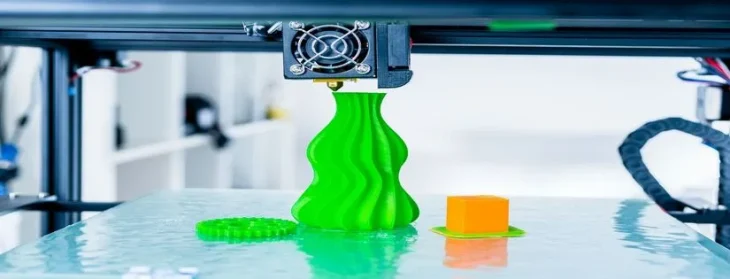Additive Manufacturing the rise of metals in 3D printing
Table of content Plastic as the basis for 3D printing Metal as the basis of 3D printing Additive manufacturing is one of the advanced techniques of Industry 4.0 that can manufacture industrial products faster and more precisely as compared to traditional manufacturing processes. Also known as 3D printing, it is a technique that works by turning a digital model of an object into a three-dimensional physical item by adding printable materials layer by layer on its digital design. It helps create complex geometrical patterns that are not possible with traditional manufacturing methods, designing and making lighter components, and controlling various material properties such as density and stiffness. 3D printing has gained popularity rapidly, involving minor prototype construction, fewer dies, and less post-processing. The aerospace and defense industry is experiencing large-scale use of 3D printing with French company Thales Group started a global center of expertise in additive manufacturing in Morocco in 2017. Boeing created its first 3D printed metal satellite antenna for the Israeli company Spacecom in 2019. Airbus used the technology to manufacture the titanium 3D printed bracket on an in series production A350 XWB commercial aircraft in 2017 and has since announced plans to develop 3D printed drones. Plastic as the basis for 3D printing Stereolithography (SLA): SLA is the first 3D printing technology ever used. It hardens a liquid resin using an ultraviolet beam, bonding each successive layer. Despite its antiquity, this technology is still widely used mainly due to a few advantages such as detail resolution, surface quality, and tight tolerances. It is used for UV-sensitive epoxy resins and ceramic-reinforced materials (NanoTool, BlueStone, CeraMax). This technique is widely used for coupling tests, dimensional verification, ergonomic studies, and wind tunnel aerodynamics tests due to its high detail resolution. Fused filament fabrication (FFF): In this process, melted thermoplastic material such as plastic, wax, or metal is sprayed from a nozzle to create many layers, each of which are bonded to the other. The bonding is done mainly by heat or adhesion. The most popular metals used here are nylon, high-density polyethylene, polycaprolactone, polycarbonate, and low melting point metals. Due to its affordability, FFF is a commonly used process for rapid prototyping parts with standard tolerances. Selective laser sintering (SLS): SLS involves hardening and bonding tiny seeds of plastic into layers in a three-dimensional structure using a laser. The powder is jet sprayed from multiple nozzles on the print area, and then the laser fuses or sinters the powder layer by layer. Based on the requirement, SLS printed objects are commonly made with plastic materials, such as nylon or any other powdered material. One of the main benefits of this technique is that, unlike many other 3D printing technologies, SLS doesn’t require much tooling once an object is printed.Unlike stereolithography, SLS doesn’t need additional supports to clasp a thing while it is being printed. Electron beam melting (EBM): Like SLS, EBM is a process that requires high energy high temperature, just that it uses an electron beam as its power source. In this, a tungsten filament in the electron beam gun is superheated to create a cloud of electrons that accelerate to approximately one-half the speed of light. A magnetic field focuses the beam to the desired diameter, while the second magnetic field directs the beam of electrons to the desired spot on the print bed. Currently, EBM is required mainly for producing refractory and reactive metals (titanium, niobium, zirconium, tantalum, etc.) and their alloys. EBM is great for melting and refining metals and alloys in water-cooled copper molds under a high vacuum. Laminated object manufacturing (LOM): Introduced by Cubic Technologies (formerly Helisys Inc.), LOM is a quick and comparatively cheaper method of 3D printing objects in various materials such as metals, plastics, or paper. It binds sheets in successive layers then cuts into the desired according to the 3D CAD model. It is a prototype-centric technique and is not used for production. Metal as the basis of 3D printing While 3D printing started by using mainly plastic as the base material, metal additive manufacturing technologies are currently the most significant growth area for additive manufacturing and include: Selective laser melting (SLM): A laser is used to melt successive layers of metallic powder until completely melted. The machine then adds additional layers of powder over the melted layer until the object is built. The aerospace and medical devices industries have witnessed the maximum use of this technology, as the manufacturing in those industries involves complex parts that can be simplified using this process. This technology was discovered in 1995 by the German research institute Fraunhofer Institute ITL. Direct Metal Laser Sintering (DMLS): Developed jointly by Rapid Product Innovations (RPI) and EOS GmbH, this technique is like SLM. The main difference is the degree to which the particles are melted. In DMLS, the particles are not completely melted. Also, the 3D printer parts are developed from excellent Aluminium or Titanium powder. Laser metal disposition (LMD): Laser Metal Disposition is also called directed energy deposition (DED). In this, a laser beam melts the metallic object and creates a pool into which the powder is fed. The powder then melts to form a deposit, and the required geometry is achieved layer by layer. The powder emitting laser and nozzle are controlled using a motion- centric system or robotic arm. This technology has been rapidly gaining traction in industries such as aerospace, tooling, transportation, and oil and gas. Electron beam melting (EBM): Originally patented and developed by the Swedish company Arcam, EBM differs from other techniques as it uses an electron beam as a power source instead of a laser to 3D print metal. The beam fully melts down the metal powder layer by layer in a high vacuum while retaining the original characteristics of the material. The technique can manufacture metal parts with 100% density and is also helpful for industries with complex components such as aerospace and medical implants.
Read More